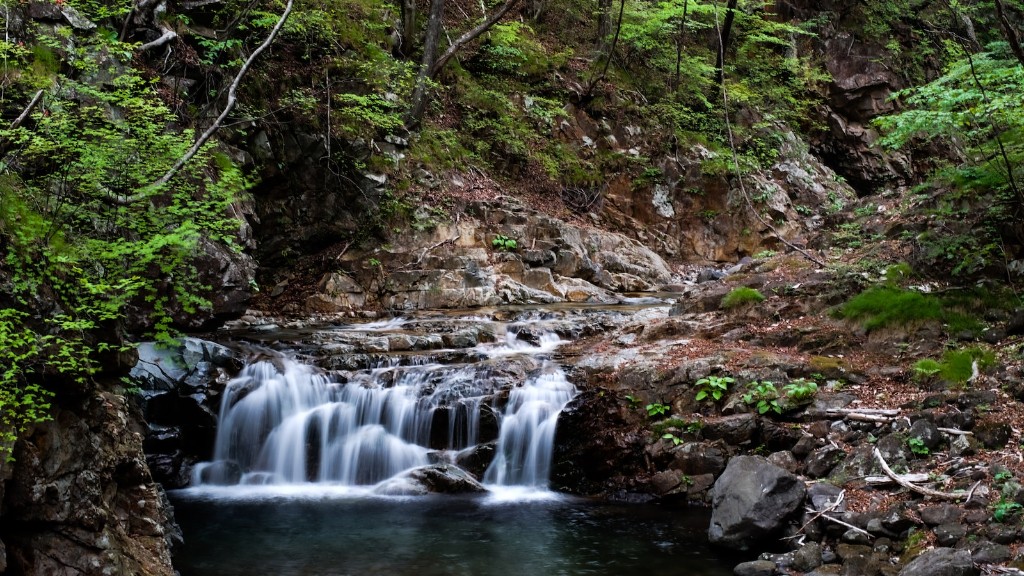The Mississippi River is an incredibly diverse body of water that harbors a vast array of different plants. Many of these plants thrive in the silt and sediment that accumulates in the waters, while some shoots and stems take root in the muddy banks. From cattails and reeds to trees and mosses, the Mississippi River is painted with a vast array of plants that make the environment unique.
The mighty river has a vast array of aquatic plants that can tolerate the changing salinity levels and pH within the water. Cattails, reeds, and rushes are a few of the most commonly seen plants that inhabit the shores of the Mississippi. These plants not only stabilize the banks from erosion but also provide food and nests for a variety of animals. In the shallows, chara and vallisneria, both aquatic plants, provide shelter for the smaller fish that dont venture in the deeper waters.
On the banks of the river, it is common to find cottonwoods, willows, and silver maples. These trees, though beautiful, can also be damaging to the rivers natural flow. Their abundance can cause blockages and reduce water quality due to their nutrient dependency. Silver maples, in particular, are especially problematic as they have shallow roots that can lead to bank erosion and increased siltation.
Mosses, ferns, and lichens also inhabit the shorelines. Mosses grow in damp conditions and help retain moisture. Ferns and lichens are found on the rocks and stumps along the river and can survive in drier conditions than other plants. These three low-lying plants are also advantageous as they dont block riverbanks as much as trees.
Experts have seen an increased occurrence of invasive species that can disrupt the environment. The most notorious invaders are hydrilla and Eurasian watermilfoil. These foreign plants expand rapidly across the river, taking up nutrients and space that could be used by native species. It is therefore important to stay on the lookout for such species and take action to remove them.
In conclusion, the Mississippi River contains a wealth of plants that provide beauty and balance within its waters. From cattails and reeds to silver maples and mosses, the landscape of the Mississippi River is vastly populated with a whole array of flora. Although experts must stay on the lookout for invasive species, the Mississippi River is still a unique and vibrant environment to explore.
Animals of the Mississippi River
Like the wide variety of plants found within the Mississippi River, a tremendous diversity of animals call this body of water their home. Furthermore, these animals have developed unique adaptations to these wetland habitats. Ducks, beavers, and muskrats are a few of the most commonly seen animals.
Ducks such as mallards, Canada geese and black ducks, to mention a few, are commonly seen gliding across the waters. They feed on the vegetation that grows in the shallows and use the river for refuge during the night. Beavers also use the river for food and shelter. Equipped with their giant flat teeth, they can gnaw down trees, creating cozy dens near the riverbank and considerable dams.
Larger animals such as bald eagles and river otters have also been spotted by visitors. Bald eagles use the river to fish, while the otters thrive in its unique underwater environment, diving in and out of the water in search of food. Along the banks, visitors can also find white-tailed deer, raccoons, and opossoms that venture close for foraging.
The Mississippi River also serves as a resting area for birds migrating from the north. Gulls, pelicans, and terns can be found around the river, taking advantage of the bounty of food available at this time of year. These migrating birds provide both activity and color to the area, making it the perfect location for birdwatchers and nature enthusiasts.
The Mississippi River is a living example of the abundance of life found in different ecological habitats. By providing both plants and animals with the space and resources they need, it is understandable why so many species call this mighty river their home.
Environmental Risks of the Mississippi River
The Mississippi River is an incredibly dynamic body of water that is subject to a wide array of environmental risks. From chemical runoff to oil spills, it is paramount that we develop and sustain responsible practices that protect this precious resource.
Chemical runoff is one of the most common issues facing the river. This runoff can come from agricultural practices in the nearby area, as well as the runoff from industries and urban areas that make their way into the tributaries and eventually, the Mississippi River. This runoff carries toxic chemicals and pollutants that can devastate the fragile ecosystems that exist within the water.
Oil spills are another large threat to the health of the Mississippi River. As this is a major waterway for commercial transportation, there is always the threat of fuel or other oils seeping into the water and polluting the environment. As we depend on this river for commerce and recreation, it is important that the appropriate safety measures are in place to protect it from such pollutants.
Furthermore, invasive species are a problem throughout the river. This is where uninvited species enter the waters and disrupt the environment by either taking up too much space or exploiting the resources. For example, zebra mussels that have made their way into the river through the transportation of boats have led to a marked decrease in water quality.
Finally, climate change has begun to have a profound effect on the Mississippi River. Rising temperatures and changing weather patterns can give rise to long-term shifts in the rivers waters, leading to serious water shortages in the nearby area. It is essential that we mitigate our carbon emissions in order to preserve the river’s natural beauty.
Conservation Efforts of the Mississippi River
As the Mississippi River is an incredibly precious resource, it is important to conserve the environment and protect it against the potential risks. Here are a few of the efforts that have been made in recent years to safeguard the health of this body of water.
The first effort is the construction of wastewater treatment facilities. These projects are focused on improving the quality of water that enters the Mississippi River and its tributaries by reducing the amount of pollution in the water. By monitoring and treating the waste properly, it is possible to keep the river’s waters clean and safe for aquatic life.
The second conservation project revolved around the use of the river for transportation. Regulations were put in place that banned the discharge of oil from boats operating in the Mississippi River. This measure was put in place to protect against the risk of oil spills and other hazardous substances.
Thirdly, the government has sponsored initiatives to encourage the restoration of the river’s banks. Hundreds of miles of the Mississippi River have been subject to bank stabilization projects, where natural vegetation is planted to control erosion and reduce siltation.
Finally, the government has also worked to restore the wetlands found within the river. This includes the restoration of wetland vegetation that provides shelter and food for a number of species, as well as the re-establishment of native species. This effort has been highly successful and has led to a noticeable improvement in the biodiversity of the river ecosystem.
Economic Importance of the Mississippi River
Apart from the obvious environmental benefits of the Mississippi River, it has an undeniable economic importance as well. The river serves as an essential source of transport, trade and recreation within the area, fostering the economies of numerous states.
One of the primary advantages of the Mississippi River is its use for transportation. The river is a major international waterway that is used to transport goods across the nation. This helps keep the costs of trade and transportation low, allowing businesses to benefit from the generated revenue.
Furthermore, the Mississippi River is a major tourist attraction in the United States. Thousands of visitors flock to the river each year to gaze upon its stunning beauty, experience the local culture and engage in recreational activities. This influx of tourists generates substantial revenue for the region, both from tickets and from local services such as restaurants and hotels.
Finally, the Mississippi River also serves as an important source of energy for the area. As the river has a natural current, it can be used to generate electric power and provide energy for the nearby towns and villages. This provides both an economic and environmental benefit, as it reduces air pollution and provide peoples with cheaper electricity.
The Mississippi River is a vast and diverse ecosystem that provides an incredible amount of natural beauty, but it is also very economically valuable. Unless we take the necessary steps to conserve and protect this precious resource, we risk losing this vital resource.
Conclusion
The Mississippi River is a beautiful body of water that is populated by a variety of plants and animals. From cattails and reeds to white-tailed deer and bald eagles, the Mississippi River is an incredibly diverse environment that serves as a refuge for a myriad of species. Additionally, the river also serves as a major economic hub, providing transportation, trade and recreation opportunities for the local population.
However, it is also important to be aware of the environmental risks that the Mississippi River is subject to. Chemical runoff, oil spills, invasive species and climate change are all potential threats to the river’s balance. Therefore, it is essential that we take the necessary safety measures and conservation efforts to ensure its health and sustainability.





